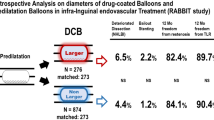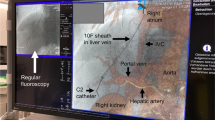Abstract
Purpose
To evaluate the radiation dose reduction during endovascular aneurysm repair (EVAR) after the reconfiguration of a Philips AlluraXper FD20 X-ray system.
Methods
Between 2013 and 2015, we implemented a low-dose protocol (Eco dose) increasing the filtration with 1 mm of Al and 0.1 of Cu on both fluoroscopy and fluorography and halving the frames per second in fluoroscopy. The switch was complemented by hybrid operating room staff education and training in radiation protection. We compared two samples of 50 patients treated before the switch (normal dose) with 50 patients treated after the switch (Eco dose). Procedures were categorized into two different grades of complexity, standard and complex, intended as fenestrated/chimney/snorkel and EVAR plus additional embolization to prevent endoleak type II. We evaluated patient demographics, Air Kerma (AK), dose area product (DAP), and procedural data (fluoroscopy time, number of fluorographies, and iodinated contrast). Staff radiation dose was measured with film badge dosimeter on C-arm.
Results
The Eco-dose protocol witnessed a DAP reduction of 53% in standard EVARs and of 57% in complex EVARs and an AK reduction of 45% in standard and 57% in complex EVAR. The image quality in 2016 was perceived acceptable, as proven by the fact that fluoroscopy time, number of fluorographies, and contrast medium volumes did not have to be increased. We achieved a reduction in staff dose of 25.6%.
Conclusions
Optimized angiographic system setting significantly reduced the radiation dose both to the patients and to the staff assuring safe EVAR procedures.



Similar content being viewed by others
References
Dua A, Kuy S, Lee CJ et al (2014) Epidemiology of aortic aneurysm repair in the United States from 2000 to 2010. J Vasc Surg 59:1512–1517. https://doi.org/10.1016/j.jvs.2014.01.007
Santosa F, Moysidis T, Nowak T et al (2012) Endovascular abdominal aneurysm repair: trends in Germany. VASA Z Gefasskrankheiten 41:268–274. https://doi.org/10.1024/0301-1526/a000202
Weerakkody RA, Walsh SR, Cousins C et al (2008) Radiation exposure during endovascular aneurysm repair. Br J Surg 95:699–702. https://doi.org/10.1002/bjs.6229
European Society of Radiology (ESR) (2015) Summary of the European Directive 2013/59/Euratom: essentials for health professionals in radiology. Insights Imaging 6:411–417. https://doi.org/10.1007/s13244-015-0410-4
Valentin J (2000) Avoidance of radiation injuries from medical interventional procedures. Ann ICRP 30:7–67. https://doi.org/10.1016/S0146-6453(01)00004-5
van den Haak RFF, Hamans BC, Zuurmond K et al (2015) Significant radiation dose reduction in the hybrid operating room using a novel X-ray imaging technology. Eur J Vasc Endovasc Surg Off J Eur Soc Vasc Surg 50:480–486. https://doi.org/10.1016/j.ejvs.2015.06.025
Kirkwood ML, Arbique GM, Guild JB et al (2013) Surgeon education decreases radiation dose in complex endovascular procedures and improves patient safety. J Vasc Surg 58:715–721. https://doi.org/10.1016/j.jvs.2013.04.004
Haqqani OP, Agarwal PK, Halin NM, Iafrati MD (2012) Minimizing radiation exposure to the vascular surgeon. J Vasc Surg 55:799–805. https://doi.org/10.1016/j.jvs.2011.08.055
Fetterly KA, Mathew V, Lennon R et al (2012) Radiation dose reduction in the invasive cardiovascular laboratory: implementing a culture and philosophy of radiation safety. JACC Cardiovasc Interv 5:866–873. https://doi.org/10.1016/j.jcin.2012.05.003
Peach G, Sinha S, Black SA et al (2012) Operator-controlled imaging significantly reduces radiation exposure during EVAR. Eur J Vasc Endovasc Surg 44:395–398. https://doi.org/10.1016/j.ejvs.2012.08.001
Mitchell EL, Furey P (2011) Prevention of radiation injury from medical imaging. J Vasc Surg 53:22S–27S. https://doi.org/10.1016/j.jvs.2010.05.139
Stecker MS, Balter S, Towbin RB et al (2009) Guidelines for patient radiation dose management. J Vasc Interv Radiol JVIR 20:S263–S273. https://doi.org/10.1016/j.jvir.2009.04.037
Walker TG, Kalva SP, Ganguli S et al (2012) Image optimization during endovascular aneurysm repair. AJR Am J Roentgenol 198:200–206. https://doi.org/10.2214/AJR.11.6608
Miller DL, Balter S, Noonan PT, Georgia JD (2002) Minimizing radiation-induced skin injury in interventional radiology procedures. Radiology 225:329–336. https://doi.org/10.1148/radiol.2252011414
van Dijk JD, Ottervanger JP, Delnoy PPHM et al (2017) Impact of new X-ray technology on patient dose in pacemaker and implantable cardioverter defibrillator (ICD) implantations. J Interv Card Electrophysiol 48:105–110. https://doi.org/10.1007/s10840-016-0200-z
Gislason-Lee AJ, Keeble C, Malkin CJ et al (2016) Impact of latest generation cardiac interventional X-ray equipment on patient image quality and radiation dose for trans-catheter aortic valve implantations. Br J Radiol 89:20160269. https://doi.org/10.1259/bjr.20160269
Kirkwood ML, Guild JB, Arbique GM et al (2016) New image-processing and noise-reduction software reduces radiation dose during complex endovascular procedures. J Vasc Surg 64:1357–1365. https://doi.org/10.1016/j.jvs.2016.04.062
de Ruiter QMB, Moll FL, Gijsberts CM, van Herwaarden JA (2016) Allura Clarity radiation dose-reduction technology in the hybrid operating room during endovascular aneurysm repair. J Endovasc Ther Off J Int Soc Endovasc Spec 23:130–138. https://doi.org/10.1177/1526602815622433
Ryckx N, Sans-Merce M, Meuli R et al (2016) System upgrade on philips allura FD20 angiography systems: effects on patient skin dose and static image quality. Radiat Prot Dosim 169:313–318. https://doi.org/10.1093/rpd/ncv484
Author information
Authors and Affiliations
Corresponding author
Ethics declarations
Conflict of interest
The authors declare that they have no conflict of interest.
Ethical standards
All procedures were in accordance with the ethical standards of the institutional research committee and with the 1964 Helsinki declaration and its later amendments or comparable ethical standards.
Rights and permissions
About this article
Cite this article
Ruffino, M.A., Fronda, M., Discalzi, A. et al. Radiation dose during endovascular aneurysm repair (EVAR): upgrade of an angiographic system from standard to Eco mode. Radiol med 123, 966–972 (2018). https://doi.org/10.1007/s11547-018-0924-1
Received:
Accepted:
Published:
Issue Date:
DOI: https://doi.org/10.1007/s11547-018-0924-1




